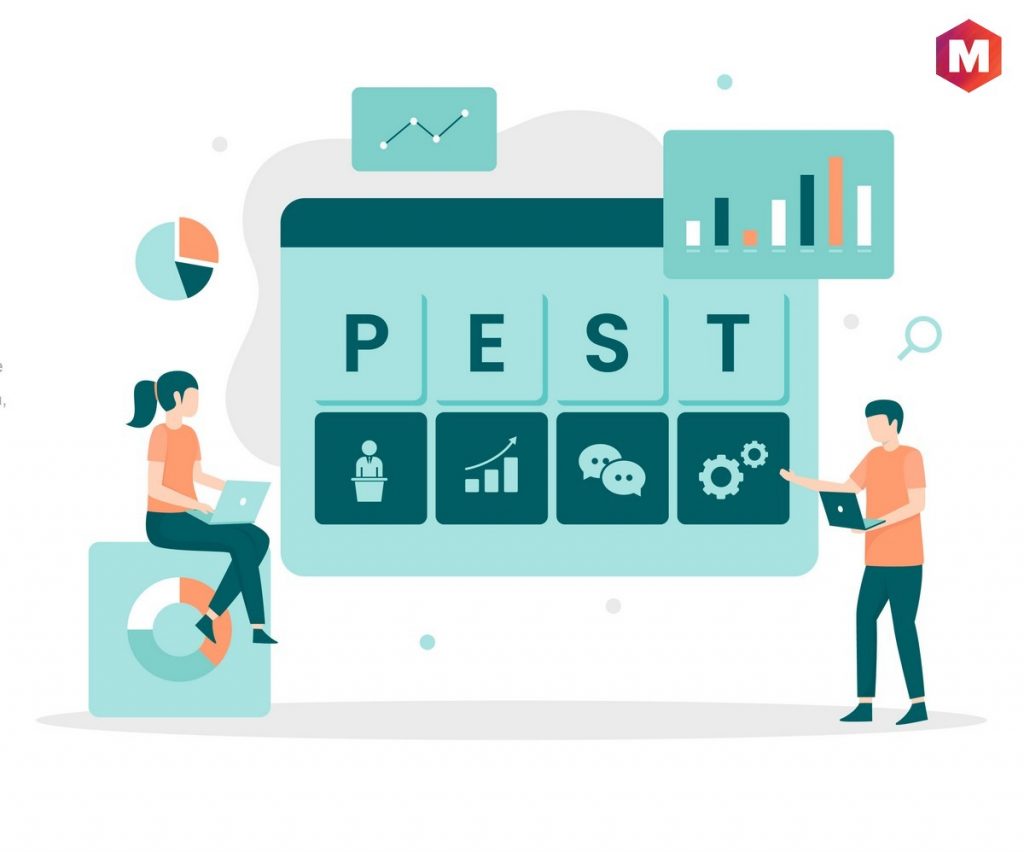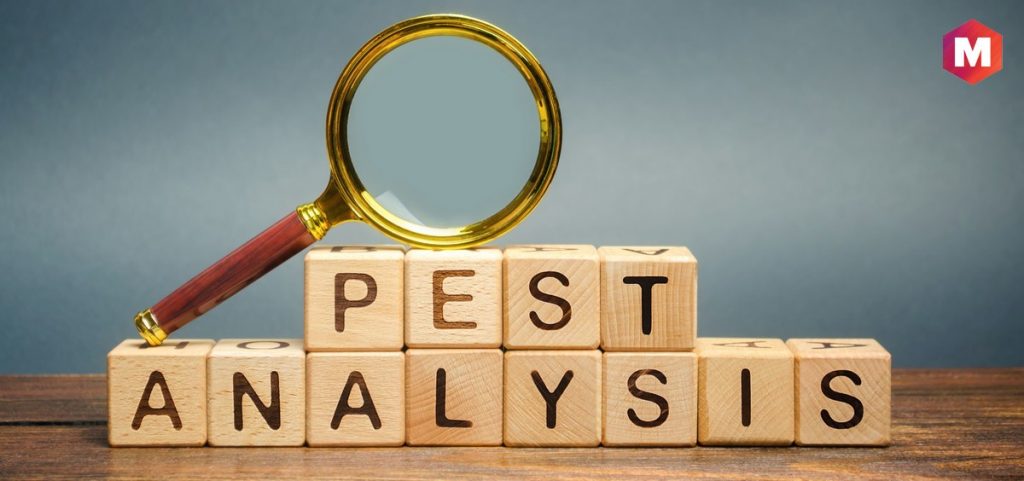Table of Contents
What Is PEST Analysis?
PEST analysis (Political, Economic, Social, and Technological) is defined as a framework used to evaluate political, economic, social, and technological factors that can have an impact on a business. The PEST analysis is a strategic planning tool that helps organizations identify and track the major external factors influencing their operation.
These four PEST factors are the key drivers of change in a business or organization. By understanding the key drivers of change, organizations can better take advantage of the opportunities they create.
PEST is an acronym for Political, Economic, Social, and Technological factors. PEST analysis is a tool used to identify and analyze the key drivers of change in a business or organization. The PEST framework can be used to help organizations understand the external factors that may impact their business.
It’s a management technique for businesses to assess and track the major external elements influencing their operation in order to stay competitive in the marketplace. It is used to provide you with a clearer understanding of the influential, “big picture” changes happening around you so that you can better take advantage of the opportunities they create.
Factors of PEST Analysis
1. Political factors
These factors include tax policy, government regulations, trade restrictions, and political stability. Political factors can have a significant impact on a business. For example, a change in tax policy could impact a company’s profitability.
Different political factors examined by a PEST analysis are-
- Taxation: The amount of tax a business pays can have a big impact on its bottom line.
- Trade restrictions: Trade restrictions are laws or regulations that restrict international trade. These restrictions can impact a company’s ability to import or export goods.
- Intellectual property protection: Intellectual property includes trademarks, copyrights, and patents.
- Environment: The environment includes all the external factors that can impact a business. This includes things like Suppliers, Customers, Government, Shareholders, and the general public.
- Employment regulations: Employment regulations are laws that govern the relationship between employers and employees. These regulations can impact things like hiring, firing, and working conditions.
- Government policy: Government policy can have a big impact on businesses. For example, a change in environmental policy could impact a company’s operations.
- Property rights: Property rights are the legal rights people have to their property. These rights can be affected by things like zoning laws and eminent domain.
2. Economic factors
These factors include economic growth, inflation, interest rates, and Exchange rates. Economic factors can have a significant impact on a business. For example, economic growth may impact a company’s demand for its products.
Some of the economic factors analyzed by PEST analysis:
- Cost of living: The cost of living is the amount of money needed to buy basic necessities like food, shelter, and clothing.
- Business investment levels: Business investment is the money businesses spend on things like machinery, buildings, and vehicles.
- Access to credit: Access to credit is the ability of a business to borrow money.
- Market conditions: Market conditions are the factors that impact the demand and supply of goods and services in a market.
- Economic growth or decline: Economic growth is the increase in the Gross Domestic Product (GDP) of a country. A recession is a period of economic decline.
- Globalization: Globalization is the process of businesses expanding into new markets around the world.
- Exchange rates and interest rates: Exchange rates are the prices of one currency in terms of another currency. Interest rates are the percentage of money charged for borrowing money.
- Labor costs and workforce skill levels: Labor costs are the wages paid to employees. Workforce skill levels are the abilities and knowledge of the workforce.
- Inflation: Inflation is the increase in the price of goods and services over time.
- Spending habits: Spending habits are the ways consumers spend their money.
- Tax levels: Tax levels are the amount of taxes imposed by the government on businesses and individuals.
3. Socio-cultural factors
These factors include demographics, social trends, and lifestyles. Socio-cultural factors can have a significant impact on a business. For example, a change in social trends may impact a company’s demand for its products.
A few social factors analyzed by PEST are
- Consumer trends/tastes/fashions: Consumer trends are the ways consumers spend their money. Tastes are the things consumers like or dislike. Fashions are the styles or designs that are popular at a particular time.
- Diversity, inclusion, and equality: The diversity of the workforce is the mix of people from different backgrounds and experiences. Inclusion is making sure that everyone in the workforce feels valued and respected. Equality is ensuring that everyone in the workforce is treated fairly and has the same opportunities.
- Attitude toward work (productivity): The attitude toward work is the way employees feel about their jobs. A positive attitude can lead to increased productivity.
- Education: The level of education in society can impact the demand for a company’s products. For example, a higher level of education may lead to a greater demand for a company’s products that require a higher level of knowledge or skill to use.
- Generational attitude shifts: A generational attitude shift is a change in the way people of a certain generation feel about something. For example, there may be a generational attitude shift toward environmental sustainability.
- Employment patterns and job market trends: Employment patterns are the ways that people are employed. Job market trends are the changes in the demand for certain types of jobs.
- Population demographics: Population demographics are the characteristics of a population, such as age, gender, income, and ethnicity. These factors can impact the demand for a company’s products.
- Population growth rate: The population growth rate is the rate at which the population is growing. This can impact the demand for a company’s products.
- The health of the population: The health of the population can impact the demand for a company’s products. For example, if the population is healthy, there may be greater demand for products that are good for one’s health.
- Social mobility: Social mobility is the movement of people from one social class to another. This can impact the demand for a company’s products.
- Unionization: Unionization is the process of forming or joining a union. This can impact the demand for a company’s products.
4. Technological factors
These factors include technological change, research and development, and new technology. Technological factors can have a significant impact on a business. For example, a change in technology may impact a company’s production process.
Some of the technological factors investigated by PEST analysis-
- Automation and robotics: Automation is the process of using technology to perform a task that would normally be done by a human. Robotics is the branch of technology that deals with the design, construction, operation, and application of robots.
- Cybersecurity and data protection: Cybersecurity is the practice of protecting computers, networks, and data from unauthorized access or theft. Data protection is the process of protecting data from unauthorized access or destruction.
- Disruptive technologies: Disruptive technologies are technologies that disrupt the way businesses operate. These technologies can have a major impact on a company’s bottom line.
- Artificial intelligence (AI): AI is the process of using computers to mimic human behavior. AI can be used to automate tasks, make decisions, and provide recommendations.
- Social networking: Social networking is the use of social media to connect with friends, family, and others. This can be done through sites such as Facebook, Twitter, and LinkedIn.
- Tech hubs: Tech hubs are areas where technology companies are concentrated. These areas are often home to a large number of tech workers and startups.
- Remote work: Remote work is the ability to work from anywhere in the world. This can be done via the internet or through other means.
- Innovation: Innovation is the process of creating new ideas or products. This can be done through research and development, or through other means.
- Research and development: Research and development is the process of creating new products or services. This can be done through innovation or through other means.
Variations of PEST analysis
1. PESTLE/PESTEL
PESTEL or PESTLE is an acronym for Political, Economic, Social, Technological, Legal, and Environmental factors.
2. PESTLIED
PESTLIED is an acronym for Political, Economic, Social, Technological, Legal, International, and Demographic factors.
3. STEEPLE
STEEPLE is an acronym for Social, Technological, Economic, Environmental, Political, Legal factors and ethical factors
4. SLEPT
SLEPT is an acronym for Social, Legal, Economic, Political, and Technological factors.
5. LONGPESTLE
LONGPESTLE is an acronym for Local, National, and Global Political, Economic, Social, and Technological, Legal, and Environment factors.
How to conduct a PEST Analysis?
1. Identify the political factors
The first step is to identify the political factors that can impact your business. Examples of political factors include tax policy, government regulations, and trade restrictions. Investigate what sorts of laws or policies affect you. Some of such factors are-
- Sourcing materials or products can be a complex process, involving many different factors such as import quotas, tariffs, price supports and subsidies, and preferences.
- Human resources (visas, vaccine requirements, Equal Employment Opportunity Commission standards)
- The manufacture and operation of a business (meeting OSHA standards)
- Taxation (IRS requirements; tax hikes, breaks, and deductions; and SEC reporting requirements)
- The marketing and customer demands for online businesses (online business law requirements, the CAN-SPAM Act)
2. Identify the economic factors
The second step is to identify the economic factors that can impact your business. Examples of economic factors include economic growth, inflation, and interest rates. These factors can have a significant impact on your business.
For example, if interest rates rise, this can impact your ability to borrow money for expansion. If inflation increases, this can eat into your profits. And if economic growth slows, this can impact your demand for products or services.
3. Identify the social factors
The third step is to identify the social factors that can impact your business. Examples of social factors include social trends, lifestyles, and demographics. These factors can have a significant impact on your business.
For example, if there is a change in social trends, this can impact your demand for products or services. If there is a change in lifestyles, this can impact your customer base. And if there is a change in demographics, this can impact your target market.
4. Identify the technological factors
The fourth step is to identify the technological factors that can impact your business. Examples of technological factors include research and development, new technology, and changes in technology. These factors can have a significant impact on your business.
For example, if new technology is developed, this can impact your production process. If there are changes in technology, this can impact your ability to compete. And if there is a change in research and development, this can impact your product or service offerings.
PESTEL is significant mostly for big businesses as it can affect the business environment in a great way.
The PESTEL framework is a tool that is used to analyze and monitor the macro-environmental (external marketing environment) factors that have an impact on an organization.
Applications of PEST Analysis
PEST analysis can be used in conjunction with other tools for business and macro-environmental analysis, such as Porter’s Five Forces and SWOT Analysis.
PEST Analysis is a business tool that can help organizations identify and take advantage of opportunities in the current business environment. It may also be used to anticipate future or current difficulties, allowing for more effective planning of how to deal with them.
PEST Analysis is a simple, yet powerful tool that can be used to assess the current business environment and form strategies for the future.
The PEST Analysis is not just restricted to evaluating external factors; it can also be used to study an organization’s internal politics, economics, social climate, and technology. After conducting the analysis, you will then be able to see the areas where the company falls short and make changes or improvements accordingly.
A PEST Analysis may be integrated with other types of strategic business analysis, such as the SWOT (strengths, weaknesses, opportunities, and threats) model, for a more comprehensive result. Comparing these finished analyses can provide a very strong basis for informed decision-making.
Benefits of PEST analysis
Some of the benefits of PEST analysis include
1. A deeper understanding of your business
PEST analysis can help you to take a step back and look at your company from a different perspective. This can be very useful when it comes to making decisions about the future direction of your business.
2. Long-term planning that is more effective
PEST analysis can help you to identify the long-term trends that will impact your business. This can be very helpful when it comes to making decisions about where to allocate your resources.
3. Increased awareness of potential threats and dangers
PEST analysis can help you to identify potential threats and dangers to your business. This can be very helpful when it comes to making decisions about how to protect your business.
4. A good deal of insight into viable business opportunities
PEST analysis can help you to identify valuable business opportunities. This can be very helpful when it comes to making decisions about how to grow your business.
PEST analysis disadvantages and limitations
1. Fluctuating surroundings
The business environment is constantly changing. This can make it difficult to conduct a PEST analysis.
2. A lot of speculation
PEST analysis relies heavily on assumptions and guesswork. This can lead to inaccurate results.
3. Overload of data
There is a lot of data available about the business environment. This can make it difficult to know where to start when conducting a PEST analysis.
4. Low accuracy
PEST analysis is not an exact science. This means that there is a risk of inaccuracy when conducting a PEST analysis.
Conclusion!
On the concluding note, it is clear that pest analysis focuses on the macro economic factors that affect the business and helps in the strategic planning processes. PEST Analysis is a very important tool that helps organizations to determine the political, economic, social, and technological factors that may have an impact on their business.
From market research to employment laws and from technology incentives to lifestyle trends, PEST Analysis takes into account a wide range of factors that can affect the business. All in all, a pest analysis helps organizations to be better prepared for the future and make informed decisions.
Liked this post? Check out the complete series on Marketing



hi
This text was very useful and interesting for me, as I am a student of marketing
Hello Hiten,
I am doing a presentation on India for my Principals based in Germany. We are basically into manufacturing of high end crystal glassware which is imported to India from Germany. Would need to put in a slide of PEST Anaysis of India Market.
Hi Gitanjali, did you manage to make a good PEST analysis of India? I do find it pretty hard to make it for India, as an dutch intern for a thai company.